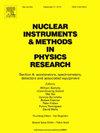Seven-dimensional trajectory reconstruction for VAMOS++
IF 1.5
3区 物理与天体物理
Q3 INSTRUMENTS & INSTRUMENTATION
Nuclear Instruments & Methods in Physics Research Section A-accelerators Spectrometers Detectors and Associated Equipment
Pub Date : 2025-03-31
DOI:10.1016/j.nima.2025.170445
引用次数: 0
Abstract
The VAMOS++ magnetic spectrometer is characterized by a large angular and momentum acceptance and highly non-linear ion optics properties requiring the use of software ion trajectory reconstruction methods to measure the ion magnetic rigidity and the trajectory length between the beam interaction point and the focal plane of the spectrometer. Standard measurements, involving the use of a thin target and a narrow beam spot, allow the assumption of a point-like beam interaction volume for ion trajectory reconstruction. However, this represents a limitation for the case of large beam spot size or extended gaseous target volume. To overcome this restriction, a seven-dimensional reconstruction method incorporating the reaction position coordinates was developed, making use of artificial deep neural networks. The neural networks were trained on a theoretical dataset generated by standard magnetic ray-tracing code. Future application to a voluminous gas target, necessitating the explicit inclusion of the three-dimensional position of the beam interaction point within the target in the trajectory reconstruction method, is discussed. The performances of the new method are presented along with a comparison of mass resolution obtained with previously reported model for the case of thin-target experimental data.
求助全文
约1分钟内获得全文
求助全文
来源期刊
CiteScore
3.20
自引率
21.40%
发文量
787
审稿时长
1 months
期刊介绍:
Section A of Nuclear Instruments and Methods in Physics Research publishes papers on design, manufacturing and performance of scientific instruments with an emphasis on large scale facilities. This includes the development of particle accelerators, ion sources, beam transport systems and target arrangements as well as the use of secondary phenomena such as synchrotron radiation and free electron lasers. It also includes all types of instrumentation for the detection and spectrometry of radiations from high energy processes and nuclear decays, as well as instrumentation for experiments at nuclear reactors. Specialized electronics for nuclear and other types of spectrometry as well as computerization of measurements and control systems in this area also find their place in the A section.
Theoretical as well as experimental papers are accepted.

 求助内容:
求助内容: 应助结果提醒方式:
应助结果提醒方式:


